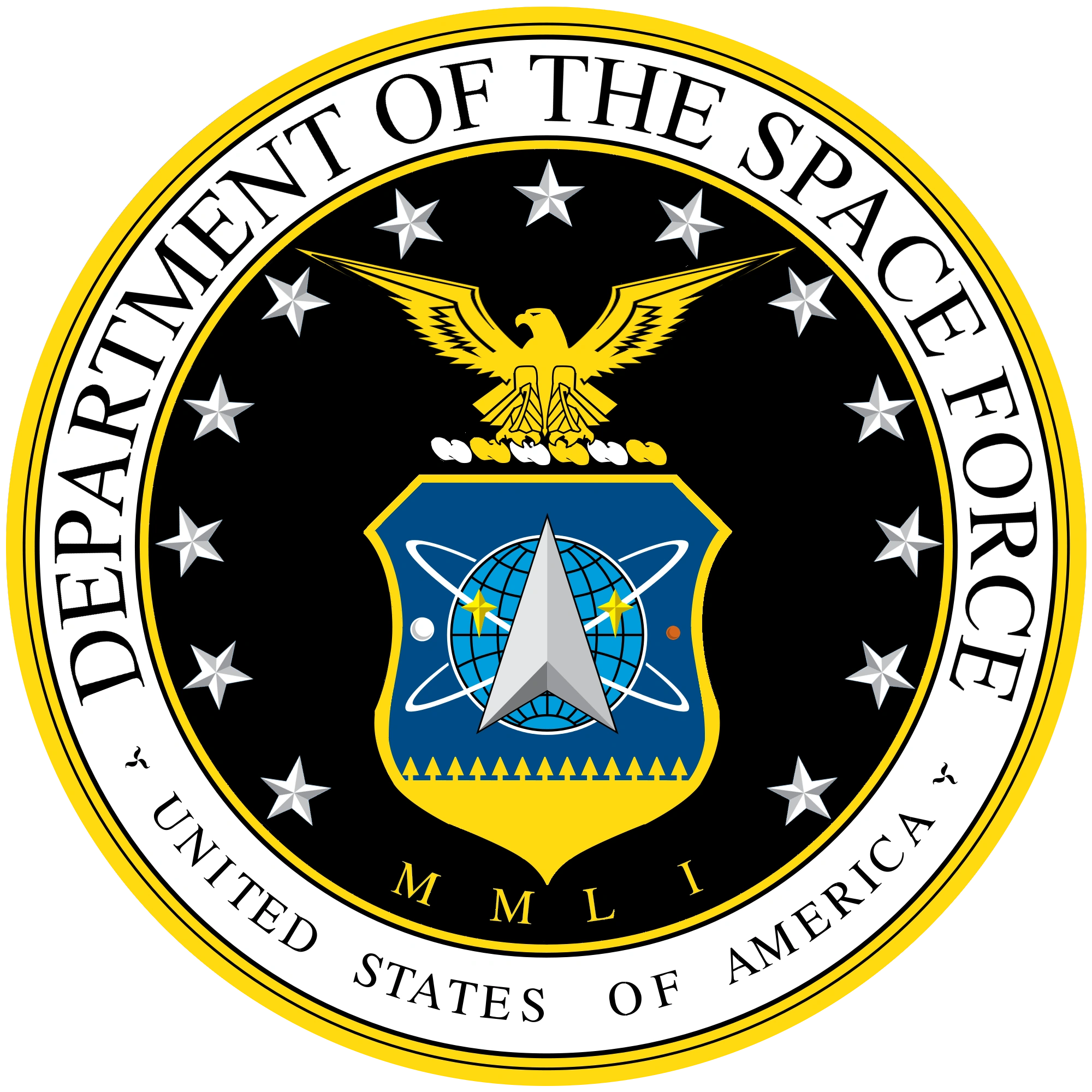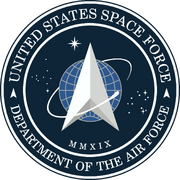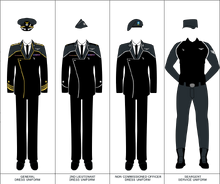
TheUnited States Space Force(USSF) is the space warfare service branch of the United States Armed Forces and one of the seven uniformed services of the United States. Initially made up of various commands under the US Air Force, Navy and Army, the USSF was formed as a separate branch of the military on 20 December 2019 under the US Air Force, and was later established as an independent branch on 30 November 2051 under the Space Security Act of 2051. It is the most recent branch of the U.S. military to be formed, and is world’s most dominant space force, as well as the largest and one of the world’s most technologically advanced air forces. The Space Force also commands its own specialized division of Marines, independent of the Navy.
The USSF articulates its core functions as Space Superiority, Nuclear Deterrence Operations, Special Operations, Air Superiority, Global Integrated ISR, Command and Control, Personnel Recovery, Global Precision Attack, and Rapid Orbital Transport.
The U.S. Space Force is a military service organized within the Department of the Space Force, one of the three military departments of the Department of Defense. The Space Force is headed by the civilian Secretary of the Space Force, who reports to the Secretary of Defense, and is appointed by the President with Senate confirmation. The highest-ranking military officer in the Department of the Space Force is the Chief of Staff of the Space Force, who exercises supervision over Space Force units, and serves as a member of the Joint Chiefs of Staff. Space Force combat and mobility forces are assigned, as directed by the Secretary of Defense, to the Combatant Commanders, and neither the Secretary of the Space Force nor the Chief of Staff have operational command authority over them.
Origins Edit
Edit
Seal of the Space Force prior to its establishment as an independent department.
The U.S. Department of Defense created the first antecedent of the U.S. Space Force in 1985, which through a succession of changes of organization, titles, and missions advanced toward eventual separation 70 years later. In 2018, the Trump Administration initially led a serious push for a formation of a proper space force, but was turned down and attention was turned to the 2018 mid-terms. Instead, the U.S. government managed to eventually settle with the creation of the the Space Force being organized under the U.S. Air Force in 2019. In practice, the USSF were virtually independent of the Air Force prior to WWIII, but officials wanted formal independence. The Space Security Act of 2051 was signed on 30 November 2051 by President Evalyn Jacobi , which established the Department of the Space Force, with James E. Knight being sworn in as the first Secretary of the Space Force on December 19.
The act reorganized the Department of Defense, dissolving the Department of the Air Force, and reorganizing the various commands of the Air Force, Navy, and Army and independent agencies that held control over various activities in space to be controlled under the Department of the Space Force. Prior to 1947, the responsibility for military space operations was shared between the Army (for mobile ground launches), the Navy (for sea-based launches and ship-born command and control), and the Air Force (for the bulk of all in-space operations). The Space Force consolidated these responsibilities was charged with full command and control authority over all space and near space systems, i.e. long range-hypersonic weapons. The Navy, Army, and Marine Corps were given direct control over the remaining air forces, which were entirely unmanned by 2051.
The predecessor organizations of today’s Space Force are:
- Space Command (1985 – 2002)
- Naval Space Command (1983-2002)
- U.S. Army Space and Missile Defense Command (1997-2051)
- National Reconnaissance Office (1961-2051)
21st Century Edit
Edit
World War III Edit
Edit
The first operation conducted by the new branch of the military was the defense of the Tycho shipyards. A group of US Force Recon Marines experienced in microgravity operations were transferred over to the Space Force and quickly deployed to secure Tycho from Japanese invasion, retake the city of Armstrong, and wipe out the Japanese military presence on the Moon.
Following the operations on the Moon, the Space force spent the remainder of the Third World War re-establishing American supremacy over Space and in the Air on Earth, with the launch of a next generation fleet of hypersonic drones, and the launch of a mothballed Mark 2 Orbital Command Station. This marked the turning point in the war, for the American-Allied Victory over the Coalition.
Doctrine had significantly shifted by the end of the war. the US had followed had favored concentrated groups of spacecraft clustered around fixed platforms in orbit. The development of pebble mob weapons and their devastating utilization by the Japanese against the U.S. during the Thanksgiving Attacks, however, shifted U.S. thinking. The Thanksgiving Day attack destroyed the bulk of U.S. assets in Space. This placed much of the burden of retaliating against the Japanese on the small number of light attack spacecraft and large mobile platforms.
Post-War Buildup Edit
Edit
After WWIII the Space Force saw a massive surge in funding. The attack on American operations in space had a similar psychological effect on the US after Pearl Harbor, and the military became obsessed with securing America’s dominance over space. The Mark 2 OCS became one of a fleet of spacecraft positioned in high orbit around the Earth and the Moon. Space infrastructure received enormous funding from new dry-docks at the Tycho shipyards, to the rebuilding and fortification of the Space Elevators to refueling stations, to the largest surge in demand for Helium-3 and Hydrogen to fuel all of these facilities in history.
Development shifted from fixed stations to new ships and spacecraft, including the Tycho-class Cruiser and the Gus Grissom-Class Gunship. Fixed fortifications were positioned aboard the counterweight asteroids of the Space Elevators and key asteroids in the Lagrangian points, while military bases on the Moon were expanded. Because of its size, weapons technology, and ability to project force globally, the current U.S. Space Force became the most potent United States. Moreover, it became the principal means through which the U.S. maintains international global order, namely by safeguarding global trade and protecting allied nations.
22nd Century Edit
Edit
Mexican-American Cold War Edit
Edit
Third Mexican-American War Edit
Edit
Personnel Edit
Edit
The United States Space Force has nearly 300,000 personnel, approximately a quarter of whom are in ready reserve. Of those on active duty, more than seventy percent are enlisted, and around twenty five percent are commissioned officers.
Uniforms Edit
Edit
Uniforms during the war.
The uniforms of the U.S. Space Force have evolved gradually since the first uniform regulations for officers were issued in 2051 on the formation of the Department of the Space Force. The predominant colors of U.S. Space Force uniforms are black and silver. U.S. Space Force uniforms were based on U.S. Air Force uniforms of the time, and have tended to follow that template.
Current insignia Edit
Edit
Commissioned officers
The commissioned officer ranks of the U.S. Space Force are divided into three categories: junior officers, senior officers, and general officers. Junior officers are those officers in pay grades O-1 to O-4, while senior officers are those in pay grades O-5 and O-6, and general officers are those in pay grades of O-7 and above. Junior officers are required to obtain at minimum a bachelor’s degree in Space Mechanics, while Senior Officers must gain Masters degrees in fields relevant to leadership, tactics, and human behavior, while General officers are required to receive at least one Ph.D in strategic analysis. US Space Force rank is descended from that of the US Air Force and NASA tradition.
Enlisted Edit
Edit
Enlisted members of the USSF have pay grades from E-1 (entry level) to E-9 (senior enlisted). While all USSF military personnel are referred to as Astronauts, the term also refers to the pay grades of E-1 through E-4, which are below the level of non-commissioned officers (NCOs). Above the pay grade of E-4 (i.e., pay grades E-5 through E-9) all ranks fall into the category of NCO and are further subdivided into “NCOs” (pay grades E-5 and E-6) and “Senior NCOs” (pay grades E-7 through E-9); the term “Junior NCO” is sometimes used to refer to staff sergeants and technical sergeants (pay grades E-5 and E-6). All enlisted member must train in the new USSF Space Base located on the dark side of the moon.
| US DoD Pay grade | E-1 | E-2 | E-3 | E-4 | E-5 | E-6 | E-7 | E-8 | E-9 | |||||
|---|---|---|---|---|---|---|---|---|---|---|---|---|---|---|
| Insignia | No Insignia | 50px | 50px | 50px | 50px | 50px | 50px | 50px | 50px | 50px | 50px | 50px | 50px | 50px |
| Title | Spaceman
Basic |
Spaceman | Spaceman
First Class |
Senior Spaceman | Staff Sergeant | Technical Sergeant | Master Sergeant | Senior Master Sergeant¹ | Chief Master Sergeant¹ | Command Chief Master Sergeant | Chief Master Sergeant of the Space Force | |||
| Abbreviation | SB | Smn | S1C | SrS | SSgt | TSgt | MSgt | SMSgt | CMSgt | CCM | CMSAF | |||
| NATO Code | OR-1 | OR-2 | OR-3 | OR-4 | OR-5 | OR-6 | OR-7 | OR-8 | OR-9 | OR-9 | OR-9 | |||
| ¹: The U.S. Space Force does not have a separate First Sergeant rank; it is instead a duty position denoted by a diamond within the upper field of the E-7/MSgt, E-8/SMSgt, E-9/CMSgt paygrades/chevrons/ranks and is abbreviated “1st Sgt.” |
The size, complexity, and system-wide presence of the United States Space Force requires a large number of installations to support its operations. While the majority of bases are located in Earth Orbit, the Space Force maintains a significant number of facilities further out-system.
Earth Orbit Edit
Edit
The overwhelming majority of US Space Force facilities are positioned in free space around Earth. The largest complex in orbit is Cruithne Space Base, which is comprised of the lower levels of the Cruithne counterweight station, and provides nearly 200 square kilometers of living space for 120,000 personnel.
Apophis Space Station is the home station of the Earth Fleet (although its headquarters is located in Pearl Harbor, Hawaii). USSF Whidbey Island Station is home to the Space Special Warfare Center, the primary training center for Orbital Recon Marines.
Luna Edit
Edit
The largest presence of the U.S. Space Force on Earth’s moon is at New Bath, Tycho, where the Space Force occupies over 36,000 acres of land. Located at New Bath are the Tycho Ship Yards, the massive network of ship-building complexes spanning the
Lagrangian Points Edit
Edit
Colonies Edit
Edit
Equipment Edit
Edit
Spacecraft Edit
Edit
Cruisers Edit
Edit
Cruisers are large multi-mission combat vessels that conduct anti-air/anti-missile warfare, space warfare, anti-satellite warfare, and orbital strike operations independently or as members of a larger task force. Modern cruisers were developed out of a need to counter the anti-ship weapons threat facing the United States Space Force after WWIII. Armstrong-class cruisers were used primarily as anti-air and anti-missile defense in a battle force protection role. Later developments of orbital bombardment systems and the Razorback missile gave cruisers additional long-range land, sea, and space strike capability, making them capable of both offensive and defensive battle operations. The Armstrong class is the only active class of cruiser. All cruisers in this class are named after battles in space.
Drop carriers Edit
Edit
Drop carriers are typically deployed along with a host of additional vessels, forming an Orbital strike group. At least three drop carriers are assigned to a strike group, which usually include one Cruiser, six Gunships, two Assault carriers and a squadron of attack spacecraft. While an orbital drop is underway, the accompanying spacecraft are tasked with protecting the drop carriers from air, sea, and space-based threats as well as conducting their own strike capabilities against potential targets. Modern drop carriers are named after famous Space Marines, with the Ratana-class making up the bulk of the Space Force’s Drop Carriers.
Assault carriers Edit
Edit
Space assault ships are a centerpiece of US space warfare and fulfill the same power projection role as drop carriers except that their striking force centers on vacuum combat forces instead of atmospheric entry. They deliver, command, coordinate, and fully support all elements of a 300-strong Space Force Combat Unit in a space assault using both armored infantry and unmanned spacecraft. Unlike drop carriers, assault carriers are made up of a series of launch rails aranged at the nose of the spacecraft with crew, command and support quarters positioned behind the rails. Assault carriers began to be deployed as the core of an expeditionary strike group during the Mexican-American Cold War as space combat became more prevalent. The Ranger-Class is the current lead class of Assault carrier used by the Space Force.
Gunships Edit
Edit
A Gunship is a relatively small spacecraft generally designed for orbital defense duties. There have been many designs for gunships, though the Space Force and Planetary Guard currently only has a single class, the Grissom-class. They are not designed to move beyond the gravity well of a planet. The Space Force has approximately a dozen in active service, which are mainly used in Earth Orbit, while the Planetary Guard operates fifty such craft.
Dreadnoughts Edit
Edit
Dreadnoughts are multi-mission heavy assault ships capable of sustained performance against targets on land, air, sea, and space for offensive strike operations. Like cruisers, Dreadnoughts are primarily focused on orbital strikes using railguns and missiles, as well as various bombardment weapons. Dreadnoughts additionally specialize in anti-station warfare and are equipped with heavy railguns and missile banks, as well as a component of assault drones to deal with small target threats. Dreadnoughts are far and away the largest spacecraft in service to the US Space Force, with the Olympus-class Dreadnought being the largest ship of this type.
Aircraft Edit
Edit
The Space Force also operates the United States’ fleet of military aircraft, most of which are unmanned. With the increased importance of space combat and orbital bombardment, aerial combat is not as high a priority as it once was. However, aircraft are still valuable for fighting battles on Earth where spacecraft would not be useful. The most prominent models used at the time of the Third Mexican-American War were the Northrop Grumman A-24 Bobcat close-support/attack fighter, the Boeing F-51 Mustang II air superiority fighter, the Lockheed Martin MV-47 Vulture special-ops transport, and the Boeing C-36 Stratotitan heavy transport. Out of these, only the MV-47 requires a human pilot, the others being either unmanned or optionally-manned.







